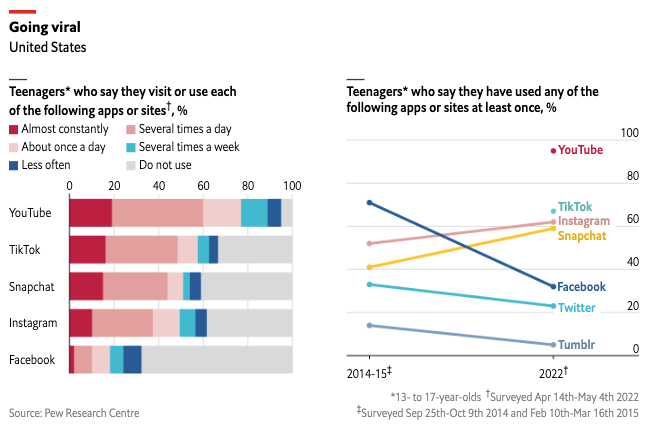
“It’s the job of old people to disapprove of everything young people do,” wrote Mark Mills in his novel “The Savage Garden”. A perennial grumble is about the amount of time the young stare at screens. Do teenagers spend too much time online? Are they addicted to social media? A new report by Pew Research Centre, a think-tank, sheds light on how often kids use the internet and social media. In April and May, Pew surveyed 1,300 Americans aged 13 to 17 about their digital media use. The survey found they happily fritter ever more time online, and are fast deserting once-popular platforms.

YouTube, one of the oldest platforms in the survey, is the most liked: 95% have used it at least once; a fifth of those are on it “almost constantly” and 77% use the app daily. Not bad for a 17-year-old platform. Facebook, just one year older than YouTube, is nonetheless a dinosaur in comparison. When Pew last polled teens in 2014-15, Facebook was the most popular social-media platform, used by 71% of respondents. Now only 32% say they have ever used it.
Teens now shun text-heavy apps, such as Facebook, Tumblr and Twitter. Only 5% of teens have ever used Tumblr, compared with 14% eight years ago. Twitter is used by just 23%, down from 33% in 2014-15. Far more popular are sites, like Snapchat and Instagram, that rely mostly on images. Older teens prefer Insta: 73% of those aged 15 to 17 say they have used it compared with 45% of those aged 13 and 14.
TikTok, a Chinese-owned video app, is the rising star: 67% of teens use it and about 16% are on it “almost constantly”. It is especially popular with girls and black teens.
Overall, young Americans are online much more than their counterparts were eight years ago. The share of youngsters who are “almost constantly” online has roughly doubled, from 24% in 2014-15 to 46% now. Another 48% use the internet “several times a day”. Despite this, most believe they spend the right amount of time on social media. Only 36% think they are on it too much. If Pew had surveyed their parents, that figure would have been nearer to 100%. ■
Comments are closed.
